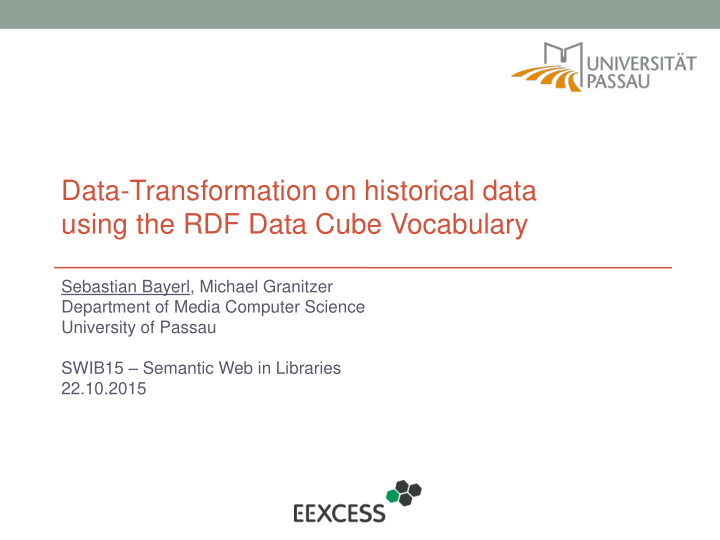



Data-Transformation on historical data using the RDF Data Cube Vocabulary Sebastian Bayerl, Michael Granitzer Department of Media Computer Science University of Passau SWIB15 – Semantic Web in Libraries 22.10.2015
2 Overview • Motivation • Vocabulary and Dataset • Problem Setting and Approach • Workflow • Contributions
3 Motivation • Statistical and historical data source • Statistics of the German Reich (Digitalized) • Access the encapsulated knowledge • Data Analytics and Recommendation • Using Linked Data (RDF Data Cube Vocabulary) • But first: Data Integration • Data Cleaning, -Transformation and -Fusion
4 Source structure
Target structure D1 D1 D1 D1 F D1 D2 D3 a b c d 1 a a a D2 D2 D2 D2 F D1 D2 D3 a a b b 2 b a a D3 F F F F F D1 D2 D3 a 1 2 3 4 3 c b a D3 F F F F … … … … b 5 6 7 8
6 Data Cubes and OLAP • Cube: Multi-dimensional data structure • Observation: measures and dimensions • Measure: numerical fact • Dimension: describes the fact(s) • Enables Data Analytics • OLAP: Online Analytical Processing • Slicing, Dicing, Roll-Up, …
The RDF Data Cube Vocabulary • RDF based vocabulary • Models an OLAP Data Cube • Interlink components with existing concepts http://www.w3.org/TR/vocab-data-cube/
8 Examples 1
9 Examples 2
10
11 Problem Setting • Data is encapsulated in multiple files • Unusable for sophisticated Data Analysis • Normalization of complex structured data • Dirty and faulty data, structure or annotations • Lots of similar problems in a huge dataset
12 Approach • Use the RDF Data Cube Vocabulary • Enables: Interlinking, merging and analytics • Use an incremental workflow • Identify fine-granular transformations • Implement the research prototype with GUI • Select, configure and chain transformations (save/load) • HTML preview
13 Workflow Java objects RDF 4.Iterate transformations 3. Merge into 7. Convert to 2. Parse fil es 5. Apply 8. Persist RDF single table RDF transformation TEI Relational database or Data-Warehouse HTML Transformations 6. Produce HTML Convert to SQL 1. Load link group Persist Data visualisation Statements
14 Transformations 1. Pre-Normalization • Sanity checks • Data Cleaning • Fix structure (e.g. spans), data and annotations • Delete row (e.g. repeating headers) • 30 more … 2. Normalization • Normalization • Compound normalization: Horizontal or vertical partitions 3. Post-Normalization • Add/merge/delete columns • Add headers/disambiguation • Add metadata • …
15 Advanced transformations • Compound transformations • Combine multiple transformation • Fix more complex problems • E.g. find problematic cells and fix with existing transformation • Transformation suggestions • Find common problems: Repeat symbol, annotation patterns • A step towards automation
16 Contributions • Modular workflow for the Data Integration process • Definition of fine granular transformation steps • Reusable within the same or for other data sources • Lift and enrich historical statistical data • Ready for Data Analytics • Current datset contains 32169 files • > 10% converted • 10 conversion chains https://github.com/bayerls/statistics2cubes
17 Thank you for your attention! Question? RDF Data Cube Vocabulary: Sebastian Bayerl http://www.w3.org/TR/vocab-data-cube/ Department of Media Computer Science University of Passau https://github.com/bayerls/statistics2cubes bayerl@dimis.fim.uni-passau.de
BACKUP
Publication • Bayerl, Sebastian, and Michael Granitzer. "Data-transformation on historical data using the RDF data cube vocabulary." Proceedings of the 15th International Conference on Knowledge Technologies and Data-driven Business. ACM, 2015.
Abstract This work describes how XML-based TEI documents, containing statistical data, can be normalized, converted and enriched using the RDF Data Cube Vocabulary. In particular we focus on a statistical real world data set, namely the statistics of the German Reich around the year 1880, which are available in the TEI format. The data is embedded in complex structured tables, which are relatively easy to understand for humans but they are not suitable for automated processing and data analysis, without heavy pre-processing, due to their varying structural properties and differing table layouts. Therefore, the complex structured tables must be validated, modified and transformed, until they are suitable for the standardized multi-dimensional data structure - the data cube. This work especially focuses on the transformations necessary to normalize the structure of the tables. Performing validation- and cleaning-steps, resolving row- and column-spans and reordering slices are available transformations among multiple others. By combining exiting transformations, compound operators are implemented, which can handle specific and complex problems. The identification of structural similarities or properties can be used to automatically suggest sequences of transformations. A second focus is on the advantages, which come by using the RDF Data Cube Vocabulary. Also, a research prototype was implemented to execute the workflow and convert the statistical data into data cubes.
Recommend
More recommend